- Do you think Brand Journalism is more effective than journalism itself?
- How do you get the ideas for the format of your articles?
- How did you end up writing in the marketing field?
Author: gast maureen e.
VR Reflection
In the New York Times virtual reality app, I experienced a video titled “The Displaced”. This video showed what it was like to be a child in a War Torn country or a refugee camp because of a war torn nation. They brought you out into their country, showed what it was like, “a day in the life” so to speak. You see their struggles and the destruction that is their country.
In publishing, I think VR is the next step. If you can bring an article to life, as NYT has done, people will feel a deeper connection and will feel more informed about a topic. There are so many ways to involve VR in publishing. From reviews of a movie that just came out to pieces on Syria and the refugee crisis. VR is the next step for publishing. In fact, I think we are already there.
I agree that VR can evoke empathy. I have learned how important empathy is for humans, but there is very little of it in the world today. Just telling someone about the refugee crisis, or mental illness, or abuse doesn’t do much. But if you were to show them, put them in the shoes of a refugee, a person with a mental illness, or someone who is abused, they will learn so much more, feel so much more, and be able to see what the problems are in the world. Empathy is key for humans and there is no true way to “learn” empathy. But virtual reality programs such as those in the NYT app can help evoke that response and make it more prevalent in the world.
Annotated Bibliographies
“Restoring Whats Been Lost.” U.S. Committee for Refugees and Immigrants. N.p., n.d. Web. 01 Apr. 2017. http://refugees.org/explore-the-issues/refugees-facts/
“Restoring Whats Been Lost” is a page on refugees.org that gives facts about who refugees are, where they come from, and why they are leaving. It was put together by the U.S Committee for Refugees and Immigrants which is an agency that works both nationally and internationally to help refugees and immigrants all over the world. The intended audience of this particular article is those who are looking to learn more about refugees and those that need to be educated on this issue. The article contains maps and pictures and statistics that are easy for anyone to understand, however it doesn’t give very specific information that people may be looking for.
The map that is found on this page is the one I would like to use as a model for the map we will put on AWE’s website. The information on the website supports my project idea, that information that is easily accessible and understandable is beneficial to donors and the general public. The information can also be used on AWE’s website as many of the asylee’s come from these same places.
World Vision Staff. “Syria Refugee Crisis: Facts You Need to Know.” World Vision. N.p., 16 Mar. 2017. Web. 01 Apr. 2017. https://www.worldvision.org/refugees-news-stories/syria-refugee-crisis-war-facts
World Vision is a non-profit organization much like AWE is. However, they work directly in Syria. This article on their website provides specific information, in bullet lists, as to what is going on in Syria and how it effects women and children. The authors wrote this with the intention to educate but also pull at the heart strings, get them to empathize with all the horrible things that are happening. That being said, there is a slant in the article is it only talks the 100% absolutely horrible that happen and not any normal day to day things that happen.
This article will be beneficial toward my research for AWE’s website as Tiffany stated that Syria is in the top 10 places their clients come from. Also, Syria is a heavy topic in the news right now with the travel ban from President Trump. I think it could be beneficial to include some information from this website on the map we are creating for AWE.
Beltran, Adriana “Children and Families Fleeing Violence in Central America.” WOLA. N.p., 21 Feb. 2017. Web. 08 Apr. 2017. https://www.wola.org/analysis/people-leaving-central-americas-northern-triangle/
This article was written by Adriana Beltran, a senior associate for Citizen Security at WOLA. She is heavily involved in the prevention of violence in the Americas but also helping those get out of violent situations and countries. Her main claims include why people are fleeing Central America. It is common to hear of people fleeing the Middle East, but not countries that are in our backyard.
This source will be very helpful in my research for AWE. There were multiple Central American countries in the top 10 place and it is important to include all of these, not just the ones you hear about in the news all the time. It will be beneficial for donors to know that asylees come from all over the world and they need our help whether they are fleeing war or homicide.
Questions for Chris Friend
- What are the benefits of having multiple topics represented in your journal?
- What type of topics are the most popular?
- What steps did you have to take to get your website looking the way it does now? Has it changed over time?
AWE Website Pitch
Many people in America today are misinformed about where refugees and asylee’s are coming from. The majority of the news circulating portrays all refugees and asylees as terrorists and a threat to our country. When I Googled “refugees” , many articles talking about terrorism and terrorist show up. When actually, these people are ESCAPING terrorism, trying to get away. On AWE’s new website, there should be correct information about these people. Who they are, where they are coming from, and why they are coming here. In a “Get the Facts” or “Explore the Issues” kind of tab.
Not only are people misinformed, but they seem to be ignorant to what is going on in other parts of the world. It’s not happening here, so why should we worry about it? But thing is, we should.
The primary audience of this website is potential donors or volunteers, people here in America. The most important thing we should do is play to their sense of empathy. We can include videos or stories or pictures of what is happening in the middle east, show why these people are fleeing. But the most important would be to highlight the stories of the people who AWE works with. Get as specific as we can be. Show the public that these are people just like us who have been put in a horrible situation and are fighting just to survive.
One thing I want to include media wise, besides the videos or stories of the people AWE works with, would be a map. When looking at refugees.org, I was very intrigued by the map and facts they included that also tell why people are fleeing these countries. This also shows that it’s more than just from the middle east people are fleeing. The map can be seen at this link by scrolling down http://refugees.org/explore-the-issues/refugees-facts/
Empathy plays a huge role in how people feel about a topic, and to experience empathy, you must experience something. Showing a map, videos, sharing stories could really play to a persons senses and they will be more inclined to donate when they feel that connection.
Citations
“Restoring Whats Been Lost.” U.S. Committee for Refugees and Immigrants. N.p., n.d. Web. 21 Mar. 2017.
Questions for Asylee
- What did you like about the 3 websites, refugees.org, Heifer, and Save the Children that you would want incorporated into the new website?
- Is there anything you want people to know about your organization that isn’t featured on the current website?
- How do you want to accept online donations? PayPal?
- Are there any specific programs that you provide that you want to highlight? What makes your organization different?
- What role do you see social media playing with your organization?
Rhetorical Analysis: refugees.org
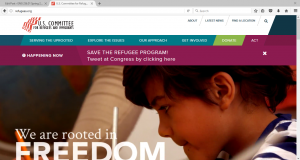
refugees.org is the official website for the U.S Committee for Refugees and Immigrants. Their purpose is to provide information to the people of the United States about who the refugees are, where they are coming from, why they are trying to enter our country, and why we need to help. In recent months, this is very important as there are many misconceptions surrounding the refugee crisis in the Middle East and these people coming to the United States. The primary audience is those who don’t know information about refugees and immigrants but want to know more, or need to know more. They also provide information for people who want to get involved and help, but don’t know how. There is a bias to this site, however it is for immigrants and refugees and the good things they provide for our country, so it is not a bad bias as many other refugee sites these days are.
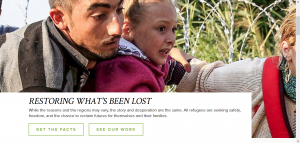
As a website, anyone with an internet connection can access it. This way, the information provided can reach almost anyone. It is a welcoming website that relies heavily on pictures to provide information. This helps it appeal to our sense of empathy. A visitor of this website sees pictures and videos of the men, women, and even children, as seen above, who are refugees. Actually seeing these pictures and learning more could make a person feel more inclined to donate to this foundation or do something in their own community. Besides pictures and videos, the pages also contain maps and other images to further show who these people are and why we should help them.
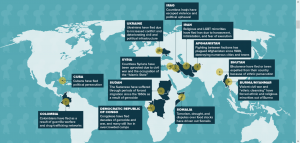
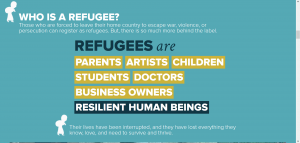
When looking at the interface of the website, many things stand out. The colors are pretty much the same throughout the site. Blue and white except for important pieces of information. On the navigation, all the buttons are blue except the two call to action choices, to Donate and Act, as seen in the first picture. On the map above, you can different colors have been used to pinpoint where these people come from and who they really are.
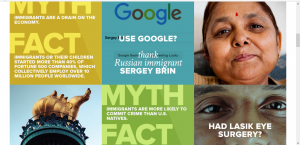
What makes the user experience so unique for this website compared the other sites we looked at, is that each page is different. Some pages you see images like the ones above, telling you different pieces of information about immigrants. You have maps, videos, pictures, success stories on other pages. You can find where these organizations are located. A donations page is set up, which is different then the rest of the site. Even the way the page scrolls is different for each page. This keeps the reader engaged and continuing to explore the site to find the other things that are hidden around each page.
To analyze this website, I used JING to provide screen-captures through this essay. These screen-captures allowed me to provide you with a visual for what I was discussing, instead of trying to describe every detail about the page I was looking at, which you as a reader wouldn’t have been able to see otherwise. Because this website was heavily image based, providing images was the best way to provide this information than trying to annotate or just talk about what is on the website. I not only learned about multimedia projects and what makes a good website, but also so much about immigrants and refugees. Exploring this website allowed to to gain knowledge I didn’t have before and alleviate any misconceptions I had toward refugees.
